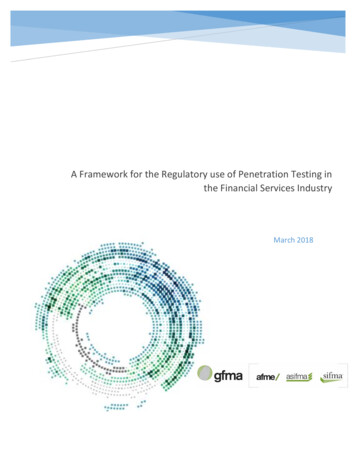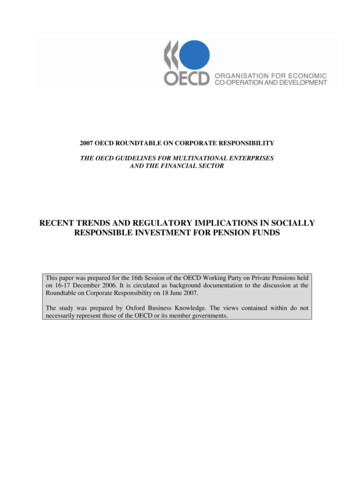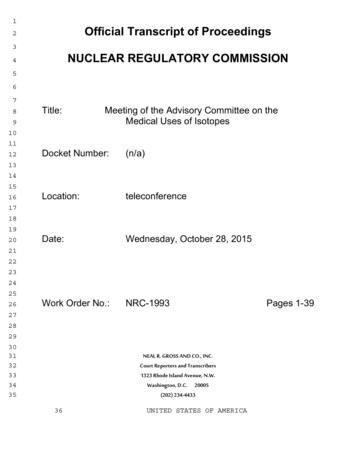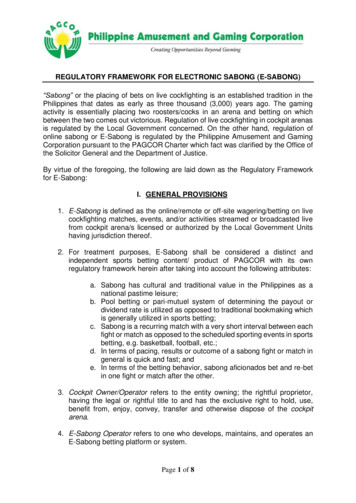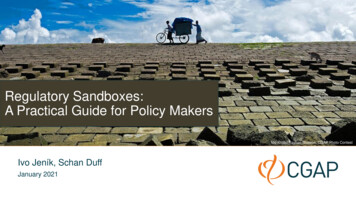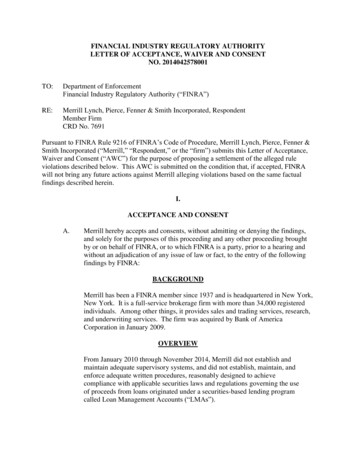
Transcription
FINANCIAL INDUSTRY REGULATORY AUTHORITYLETTER OF ACCEPTANCE, WAIVER AND CONSENTNO. 2014042578001TO:Department of EnforcementFinancial Industry Regulatory Authority (“FINRA”)RE:Merrill Lynch, Pierce, Fenner & Smith Incorporated, RespondentMember FirmCRD No. 7691Pursuant to FINRA Rule 9216 of FINRA’s Code of Procedure, Merrill Lynch, Pierce, Fenner &Smith Incorporated (“Merrill,” “Respondent,” or the “firm”) submits this Letter of Acceptance,Waiver and Consent (“AWC”) for the purpose of proposing a settlement of the alleged ruleviolations described below. This AWC is submitted on the condition that, if accepted, FINRAwill not bring any future actions against Merrill alleging violations based on the same factualfindings described herein.I.ACCEPTANCE AND CONSENTA.Merrill hereby accepts and consents, without admitting or denying the findings,and solely for the purposes of this proceeding and any other proceeding broughtby or on behalf of FINRA, or to which FINRA is a party, prior to a hearing andwithout an adjudication of any issue of law or fact, to the entry of the followingfindings by FINRA:BACKGROUNDMerrill has been a FINRA member since 1937 and is headquartered in New York,New York. It is a full-service brokerage firm with more than 34,000 registeredindividuals. Among other things, it provides sales and trading services, research,and underwriting services. The firm was acquired by Bank of AmericaCorporation in January 2009.OVERVIEWFrom January 2010 through November 2014, Merrill did not establish andmaintain adequate supervisory systems, and did not establish, maintain, andenforce adequate written procedures, reasonably designed to achievecompliance with applicable securities laws and regulations governing the useof proceeds from loans originated under a securities-based lending programcalled Loan Management Accounts (“LMAs”).
In addition, from January 2010 through July 2013, Merrill did not establishand maintain adequate supervisory systems, and did not establish, maintain,and enforce adequate written procedures, reasonably designed to ensure thesuitability of transactions in certain Puerto Rico securities, includingmunicipal bonds and closed-end funds, where customers’ holdings werehighly concentrated in PR Securities and highly leveraged through eitherLMAs or margin.By virtue of these failures, Merrill violated NASD Rule 30101 and FINRARule 2010.FACTS AND VIOLATIVE CONDUCTA. Supervision of LMAs1.Restrictions on the use of LMA proceedsMerrill LMAs are lines of credit that allow firm customers to borrow moneyfrom Bank of America, N.A. (“BANA”) using the securities held in theirMerrill brokerage accounts as collateral. From January 2010 throughNovember 2014 (the “LMA review period”), Merrill opened more than121,000 LMAs with more than 85 billion in aggregate credit extended byBANA as of August 31, 2014. As of early November 2014, there were nearly65,000 open Merrill non-purpose LMAs with loan balances aggregatingapproximately 27.4 billion.During the LMA review period, Merrill registered representatives presentedcustomers with information concerning the availability of LMAs. Whencustomers expressed interest, Merrill registered representatives typicallyexplained the product, facilitated the customer’s completion of the requiredpaperwork, and then had the completed paperwork forwarded for review andapproval. Merrill representatives were not compensated for opening LMAs,but could earn compensation if the customer used the LMA. Although theloan proceeds came from BANA, LMA accounts were established in thecustomers’ names with Merrill and Merrill custodied the collateral andmonitored collateral valuation for risk purposes.LMAs are designated as either “purpose” or “non-purpose,” and the LMAagreements prohibited proceeds from non-purpose LMAs from being used topurchase “margin stock.” This contractual restriction correlates to FederalReserve Board Regulation U, which governs securities-based loans issued bynon-broker-dealers.2 Under Regulation U, “purpose” credit is defined as “any1NASD Rule 3010 was superseded by FINRA Rule 3110 effective December 1, 2014, after thetime period relevant to this AWC.2Regulation U was promulgated under Section 7 of the Securities Exchange Act of 1934.2
credit for the purpose, whether immediate, incidental, or ultimate, of buyingor carrying margin stock.” Regulation U prohibits purpose loans fromexceeding the “maximum loan value”—which, during the relevant timeperiod, was 50% of the current market value for margin stock and “good faithloan value” for all other collateral—of the securities serving as collateral (the“collateral requirement”). Regulation U was adopted to, among other things,prevent the excessive use of credit for the purchase or carrying of marginstock.The paperwork for opening an LMA included Form U-1, commonly referredto as a “purpose statement,” which required that the applicant indicatewhether the proceeds of the loan would be used to purchase or carry marginstock. If the answer was “yes,” Form U-1 required the listing of the securitiesthat would serve as collateral for the loan.2. Merrill’s inadequate supervision of LMAsMerrill’s supervision of the LMA program was not reasonably designed toachieve compliance with certain applicable federal securities laws andregulations and FINRA rules.For example, Merrill did not adequately educate its representatives aboutLMAs or train them on the differences between purpose and non-purposeLMAs, the contractual and firm prohibition against using proceeds from nonpurpose LMAs to buy margin stock, or the regulatory requirements applicableto LMAs used to buy margin stock. Merrill also did not reasonably supervisethe LMA account-opening process. For example, representatives were notrequired to explain to the customer the difference between purpose and nonpurpose LMAs, the restrictions that came with non-purpose LMAs, or thecollateral requirement for LMAs used to purchase margin stock. In manyinstances, the completed Form U-1s were gathered from the customer andsubmitted for approval by sales assistants. Consequently, the Form U-1 couldbe accepted in situations where the customer had not discussed the purpose ofthe loan proceeds with a Merrill financial advisor.Additionally, Merrill did not establish and maintain reasonable supervisorysystems, or establish, maintain, and enforce adequate written procedures,designed to prevent, deter, and detect the use of proceeds from non-purposeLMAs to purchase margin stock. Except in limited situations where acustomer had an open margin debit balance or a pending trade, there was noeffective control in place to prevent customers from transferring proceedsfrom a non-purpose LMA to their Merrill brokerage account and immediatelypurchasing margin stock, nor any effective post-transaction review to detectsuch prohibited use of the LMA proceeds. This failure to supervise extendedto the firm’s policies and procedures, which prohibited the use of proceedsfrom non-purpose LMAs to purchase securities generally, and to the LMA3
agreements, which prohibited the use of proceeds from non-purpose LMAs topurchase margin stock. Likewise, because Merrill did not have adequatesystems to monitor whether proceeds from non-purpose LMAs were used topurchase margin stock, the firm failed to adequately monitor to ensure thecollateral requirement was met in those instances when LMA proceeds were,in fact, used to purchase margin stock.As a result of these failures, during the LMA review period, Merrillcustomers drew down on non-purpose LMAs, transferred the funds to theirMerrill brokerage accounts, and within a short timeframe (often the same day)on thousands of occasions purchased margin stock. For example, during anine-month sample period from January through September 2014, 545 Merrillbrokerage accounts received proceeds transferred from non-purpose LMAsand collectively purchased 74.28 million in securities—a majority of whichwas margin stock—within 14 days of the transfer. One high-net-worthcustomer in particular, over a period of several years, used approximately 282 million in proceeds from multiple non-purpose LMAs to makeunsolicited purchases of margin stock—generally mutual funds—often withinthe same day and in amounts identical to the LMA draw. Despite thesetransactions and an internal risk review of this customer’s account, Merrill didnot detect the connection between the transfers from the non-purpose LMAsto the brokerage accounts and the subsequent margin stock purchases.3B. Supervision of Suitability of Transactions in Puerto Rico SecuritiesFrom January 2010 through July 2013, Merrill failed to establish andmaintain a supervisory system, and failed to establish, maintain, and enforcewritten procedures, reasonably designed to ensure the suitability oftransactions in Puerto Rico municipal bonds and Puerto Rico closed-endfunds (“PR Securities”) in certain circumstances. PR Securities providePuerto Rico residents with various tax advantages, including exemption fromU.S. estate and gift taxes. The Puerto Rican government further incentivizedPuerto Rican residents to invest in PR Securities by establishing a Puerto Ricoestate tax applicable to property held by a Puerto Rico resident outside ofPuerto Rico. In addition, the PR Securities generally offer a triple tax benefit.During this time, and as a result of these unique benefits, many Puerto Ricocustomers were concentrated in PR Securities, and many used leverage tobuy additional PR Securities either through LMAs or through the use ofmargin in their securities accounts. Leveraged customers were required tomaintain account equity in order to provide adequate collateral to supporttheir leverage. Those who were both leveraged and highly concentrated in3Merrill discovered the activity in the customer’s account in early 2014 and promptly thereaftertook remedial action, including developing more robust procedures and controls, to address theuse of non-purpose LMAs to fund margin stock purchases. FINRA did not identify any customerharm resulting from these transactions.4
PR Securities bore significant risk that a single market event affecting thevalue of those securities might significantly decrease their total account valueand their equity. That risk increased during late 2012 and early 2013 as thePuerto Rico debt market became more precarious.Despite this risk, during the relevant timeframe, the firm did not establish andmaintain adequate supervisory systems and procedures to ensure that, wherecustomers were both highly concentrated in PR Securities and using leverage,transactions were suitable in light of the customers’ risk objectives andprofiles.As of July 2013, several hundred customer accounts in Merrill’s Puerto Ricobranch with modest net worth and conservative or moderate investmentobjectives had 75% or more of their account assets invested in PR Securities.Of those accounts, approximately 50 also were leveraged through LMAs ormargin. Approximately half of those accounts eventually received margin ormaintenance calls upon which they liquidated PR Securities at a loss. Thesecustomers—25 in total—suffered aggregate losses of nearly 1.2 million as aresult of liquidating PR Securities to meet the calls.C. ViolationsBy virtue of the foregoing supervisory failures, Merrill violated NASD Rules3010(a) and 3010(b) and FINRA Rule 2010.OTHER FACTORSIn determining the appropriate sanction, FINRA considered the followingfactors: (a) prior to detection by a regulator, the firm conducted acomprehensive internal review of the use of non-purpose LMA proceeds topurchase margin stock and took remedial measures to strengthen its relatedcontrols and procedures; (b) the firm reported to FINRA certain of theviolations addressed in the AWC; and (c) the firm provided substantialassistance during FINRA’s investigation by sharing the results of its internalinvestigation with FINRA staff.5
B.The firm also consents to the imposition of the following sanctions: a censure; a 6,250,000 fine; and restitution (including prejudgment interest) in the aggregate amount of 779,999, to be paid to 22 affected Merrill PR customers (“eligiblecustomers”).4A registered principal on behalf of Respondent shall submit satisfactory proofof payment of restitution or of reasonable and documented efforts undertakento effect restitution. Such proof shall be submitted by e-mail from a workrelated account of the registered principal of Respondent to Kathleen Cuomoat kathleen.cuomo@finra.org. This proof shall be provided to the FINRAstaff members listed above no later than 120 days after acceptance of theAWC.If for any reason Respondent cannot locate any customer after reasonable anddocumented efforts within 120 days from the date the AWC is accepted, orsuch additional period agreed to by a FINRA staff member in writing,Respondent shall forward any undistributed restitution and interest to theappropriate escheat, unclaimed property or abandoned property fund for thestate in which the customer is last known to have resided. Respondent shallprovide satisfactory proof of such action to the FINRA staff memberidentified above and in the manner described above, within 14 days offorwarding the undistributed restitution and interest to the appropriate stateauthority.In the event an eligible customer accepts payment of restitution as provided for in thisAWC, the firm may require from the eligible customer that the firm and persons currentlyor formerly associated with the firm be released from any additional liability relating tothe facts of this AWC. In the event an eligible customer has a pending arbitration claimagainst the firm and persons currently or formerly associated with the firm, on or beforethe effective date of this AWC, the firm shall permit the eligible customer to choose tomaintain his or her claim and direct the restitution payment to an escrow account, whichwill be distributed to the customer if no arbitration award is received through the claim.In the event an award is received for an amount less than the restitution amount, the firmshall reduce its restitution payment to the eligible customer by the amount of the award.In the event an award is received for an amount greater than the restitution amount, thefirm shall permit the eligible customer to choose either (1) the restitution amount or (2)the arbitration award, and if the eligible customer chooses the award, the escrowedrestitution amount will be returned to the firm. Restitution will not be owed to customerswho have received an arbitration decision, award, entered into a settlement agreement, or4The amount of restitution ordered takes into account that Merrill has already reimbursed certainaffected customers pursuant to private settlement agreements.6
otherwise agreed to the resolution of their claims with the firm, relating to the facts ofthis AWC, on or before the date of this AWC.The firm specifically and voluntarily waives any right to claim that it is unable to pay,now or at any time hereafter, the monetary sanction imposed in this matter.The imposition of a restitution order or any other monetary sanction herein, and thetiming of such ordered payments, does not preclude customers from pursuing their ownactions to obtain restitution or other remedies.The firm agrees to pay the monetary sanction upon notice that this AWC has beenaccepted and that such payment is due and payable. The firm has submitted an Electionof Payment form showing the method by which it proposes to pay the fine imposed.The sanctions imposed herein shall be effective on a date set by FINRA staff.II.WAIVER OF PROCEDURAL RIGHTSThe firm specifically and voluntarily waives the following rights granted under FINRA’s Codeof Procedure:A.To have a Complaint issued specifying the allegations against it;B.To be notified of the Complaint and have the opportunity to answer theallegations in writing;C.To defend against the allegations in a disciplinary hearing before a hearing panel,to have a written record of the hearing made and to have a written decision issued;andD.To appeal any such decision to the National Adjudicatory Council (“NAC”) andthen to the U.S. Securities and Exchange Commission and a U.S. Court ofAppeals.Further, the firm specifically and voluntarily waives any right to claim bias or prejudgment of theChief Legal Officer, the NAC, or any member of the NAC, in connection with such person’s orbody’s participation in discussions regarding the terms and conditions of this AWC, or otherconsideration of this AWC, including acceptance or rejection of this AWC.The firm further specifically and voluntarily waives any right to claim that a person violated theex parte prohibitions of FINRA Rule 9143 or the separation of functions prohibitions of FINRARule 9144, in connection with such person’s or body’s participation in discussions regarding theterms and conditions of this AWC, or other consideration of this AWC, including its acceptanceor rejection.7
III.OTHER MATTERSThe firm understands that:A.Submission of this AWC is voluntary and will not resolve this matter unless anduntil it has been reviewed and accepted by the NAC, a Review Subcommittee ofthe NAC, or the Office of Disciplinary Affairs (“ODA”), pursuant to FINRA Rule9216;B.If this AWC is not accepted, its submission will not be used as evidence to proveany of the allegations against the firm; andC.If accepted:D.1.this AWC will become part of the firm’s permanent disciplinary recordand may be considered in any future actions brought by FINRA or anyother regulator against it;2.this AWC will be made available through FINRA's public disclosureprogram in accordance with FINRA Rule 8313;3.FINRA may make a public announcement concerning this agreement andthe subject matter thereof in accordance with FINRA Rule 8313; and4.the firm may not take any action or make or permit to be made any publicstatement, including in regulatory filings or otherwise, denying, directly orindirectly, any finding in this AWC or create the impression that the AWCis without factual basis. The firm may not take any position in anyproceeding brought by or on behalf of FINRA, or to which FINRA is aparty, that is inconsistent with any part of this AWC. Nothing in thisprovision affects the firm’s: (i) testimonial obligations; or (ii) right to takelegal or factual positions in litigation or other legal proceedings in whichFINRA is not a party.The firm may attach a Corrective Action Statement to this AWC that is astatement of demonstrable corrective steps taken to prevent future misconduct.Merrill understands that it may not deny the charges or make any statement that isinconsistent with the AWC in this Statement. This Statement does not constitutefactual or legal findings by FINRA, nor does it reflect the views of FINRA or itsstaff.8
1. Restrictions on the use of LMA proceeds Merrill LMAs are lines of credit that allow firm customers to borrow money from Bank of America, N.A. (“BANA”) using the securities held in their Merrill brokerage accounts as collateral. From January 2010 through November 2014 (the “LMA r

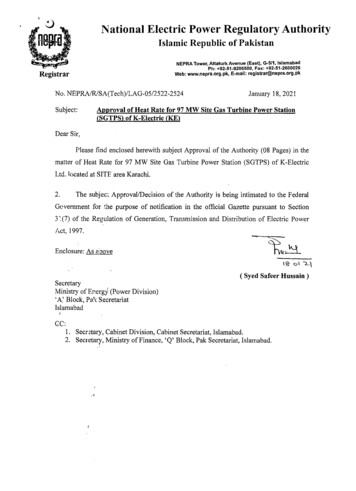
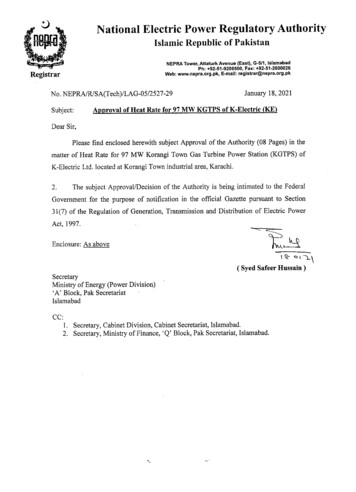
![Financial Services Regulatory Reform (00C) [Read-Only]](/img/2/2018-03-29-davis-polk-financial-services-regulatory-reform-tool-march-2018.jpg)


